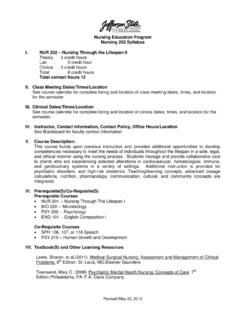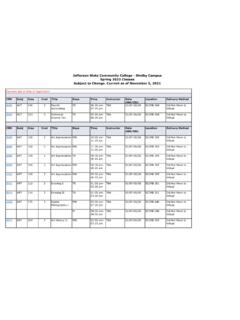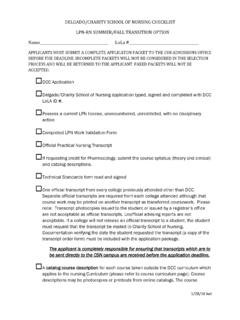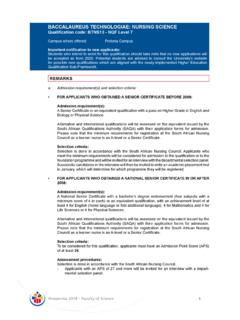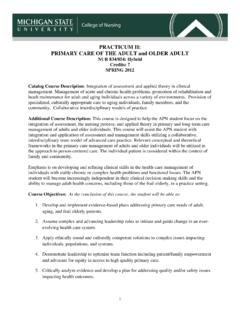Transcription of NUR 102 Fundamentals of Nursing Syllabus I. NUR …
1 Revised May 22, 2012 Nursing Education Program NUR 102 fundamentals of nursing syllabus i . NUR 102 Fundamentals of Nursing Theory 3 credit hours Lab 2 credit hours Clinical 1 credit hour Total 6 credit hours Total contact hours 12 II. Class Meeting Dates/Times/Location See Blackboard III. Clinical Dates/Times/Location See Schedule IV. Instructor, Contact Information, Contact Policy, Office Hours/Location See Blackboard for faculty contact information V. Course Description: This course provides opportunities to develop competencies necessary to meet the needs of individuals throughout the lifespan in a safe, legal, and ethical manner using the Nursing process.
2 Students learn concepts and theories basic to the art and science of Nursing . The role of the nurse as a member of the healthcare team is emphasized. Students are introduced to the concepts of client needs, safety, communication, teaching/learning, critical thinking, ethical-legal, cultural diversity, Nursing history, and the program's philosophy of Nursing . Additionally, this course introduces psychomotor Nursing skills needed to assist individuals in meeting basic human needs. Skills necessary for maintaining microbial, physical, and psychological safety are introduced along with skills needed in therapeutic interventions.
3 At the conclusion of this course students demonstrate competency in performing basic Nursing skills for individuals with common health alterations. Prerequisite Courses None Co-Requisite Courses NUR 103 Health Assessment NUR 104 Introduction to Pharmacology BIO 201 Human Anatomy and Physiology MTH 100 Mathematical Applications (or higher) (NOTE: MTH 116 is not acceptable) VI. Textbook(S) and Other Learning Resources Adams, M., & Holland, L. N. (2009). Pharmacology for nurses: A pathophysiologic approach (3rd ed.). Upper Saddle River, NJ: Pearson.
4 Berman, A. J., & Snyder, S. J. (2012). Kozier & Erb s Fundamentals of Nursing : Concepts, process, and practice (9th ed.). Upper Saddle River, NJ: Pearson. Wilkinson, J. M., & Ahern, N. R. (2009). Nursing diagnosis handbook (9th ed.). Upper Saddle River, NJ: Pearson. Wilson, B., Shannon, M. T., & Shields, K. M. (2012). Nurse s drug guide 2012. Upper Saddle River, NJ: Pearson. Codes for MyNursingLab and online Medical Terminology course (included in bundle) NUR 102 Lab supplies student kit (purchased through Meridy s) NUR 102 Fundamentals of Nursing 2 Revised May 22, 2012 Blackboard Learning System Current edition of a medical dictionary VII.
5 Level I Objectives At the completion of Level I, the associate degree Nursing student will be able to: 1. Demonstrate competency in performing basic skills for individuals with common health alterations. 2. Utilize foundational knowledge of the communication process in providing Nursing care for clients across the lifespan. 3. Apply foundational knowledge of the Nursing process in providing Nursing care for clients across the lifespan. 4. Utilize critical thinking skills in formulating a plan of care for clients with common health alterations in a variety of settings.
6 5. Utilize a teaching/learning plan for culturally diverse clients with common health alterations in a variety of settings. 6. Develop competencies necessary to meet the needs of individuals throughout the lifespan in a safe, legal, and ethical manner using the Nursing process. 7. Utilize relevant technology for client care and documentation. 8. Demonstrate professional behaviors associated with Nursing . VIII. Instructional Goals 1. Cognition: Comprehend knowledge of Nursing Fundamentals and the Nursing process. 2. Performance: Apply knowledge of Nursing Fundamentals and the Nursing process in a simulated and clinical environment.
7 IX. Course Outcomes 1. Assess vital signs. 2. Utilize the Nursing process and critical thinking skills. X. Professional Competencies/Objectives Module A Safety Promote safe and secure environment. Provide environmental safety and security. Identify safety risk factors. Explain body mechanics risk factors. Explain positioning, transfer, and ambulation. Define environmental hazards. Identify safety restraints. Explain guidelines and risk factors for using safety restraints. Explain the process of using safety restraints.
8 Identify the hazards of immobility. Identify the nurse s role in disaster management. Identify issues related to risk management. Explain the importance of risk management. Demonstrate aseptic techniques. Identify types of asepsis. Explain medical and surgical aseptic procedures including isolation. Explain the chain of infection. Explain the infectious process. Explain the consequences of infection. Explain the inflammatory process. Identify diagnostic values related to inflammation and infection.
9 NUR 102 Fundamentals of Nursing 3 Revised May 22, 2012 Identify OSHA guidelines for healthcare providers, including isolation. Identify standard precautions. Demonstrate reporting procedures and techniques for safety and security. Identify measures that ensure a secure environment. Define documentation processes for safety and security. Explain the process of reporting breaches in safety and security. Module A Clinical/Lab Skills 1. Safety and security measures 2. Wound care 3. Restraints 4. Body mechanics 5.
10 Range of motion 6. Positioning, transfer, and ambulation 7. Assistive devices 8. Hand washing 9. Personal protective equipment 10. Safety documentation and reporting procedures 11. Isolation techniques Module B - Integumentary System Alterations Provide care for clients with selected integumentary system alterations. Assess a client for selected integumentary system alterations. Explain the anatomy and physiology of integumentary system. Define terms associated with integumentary system alterations. Identify causes of integumentary system alterations.
